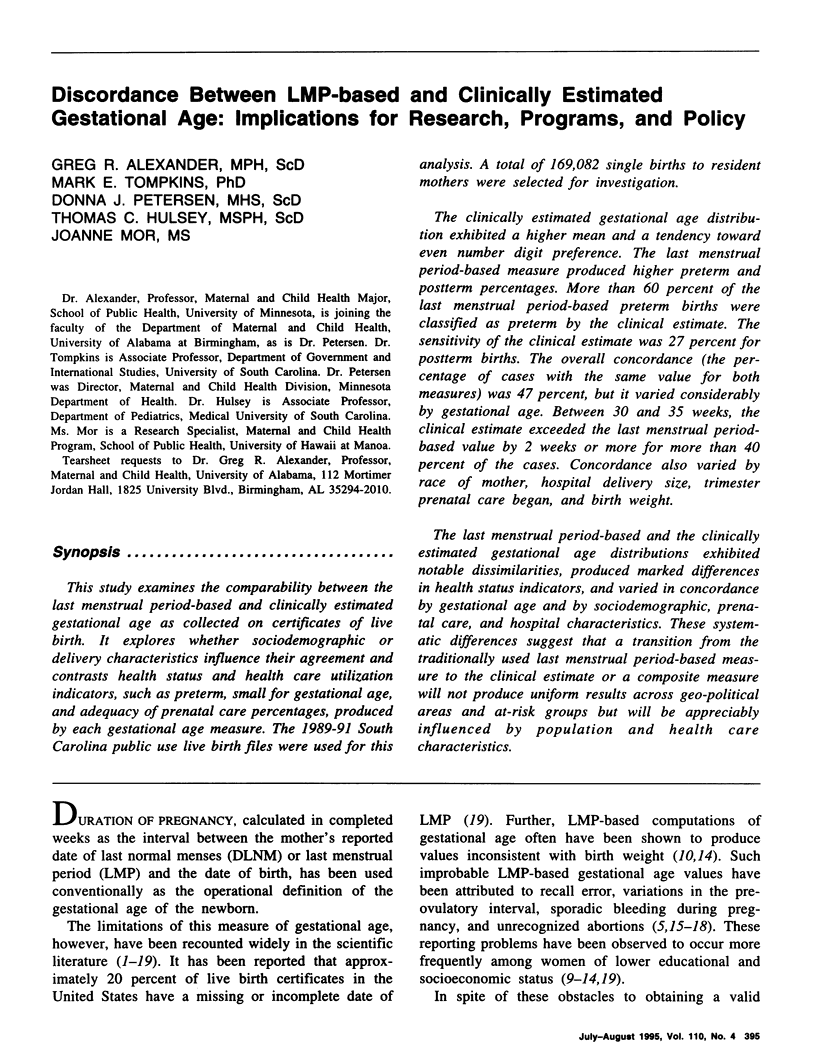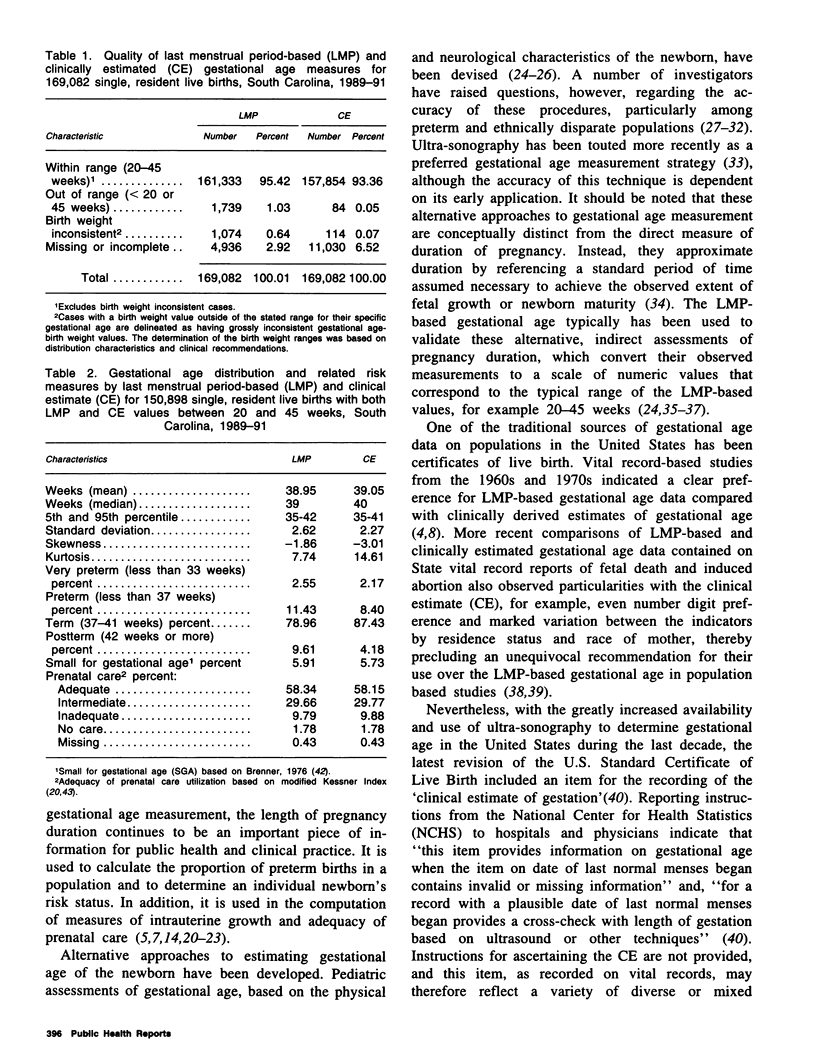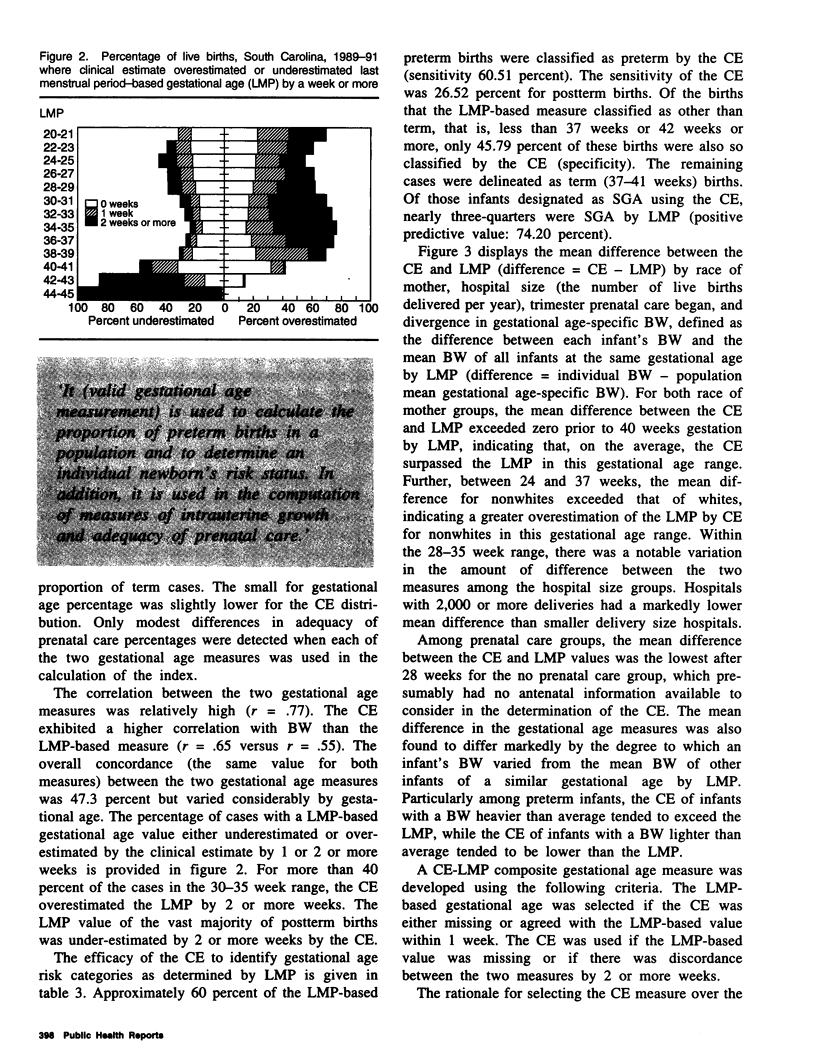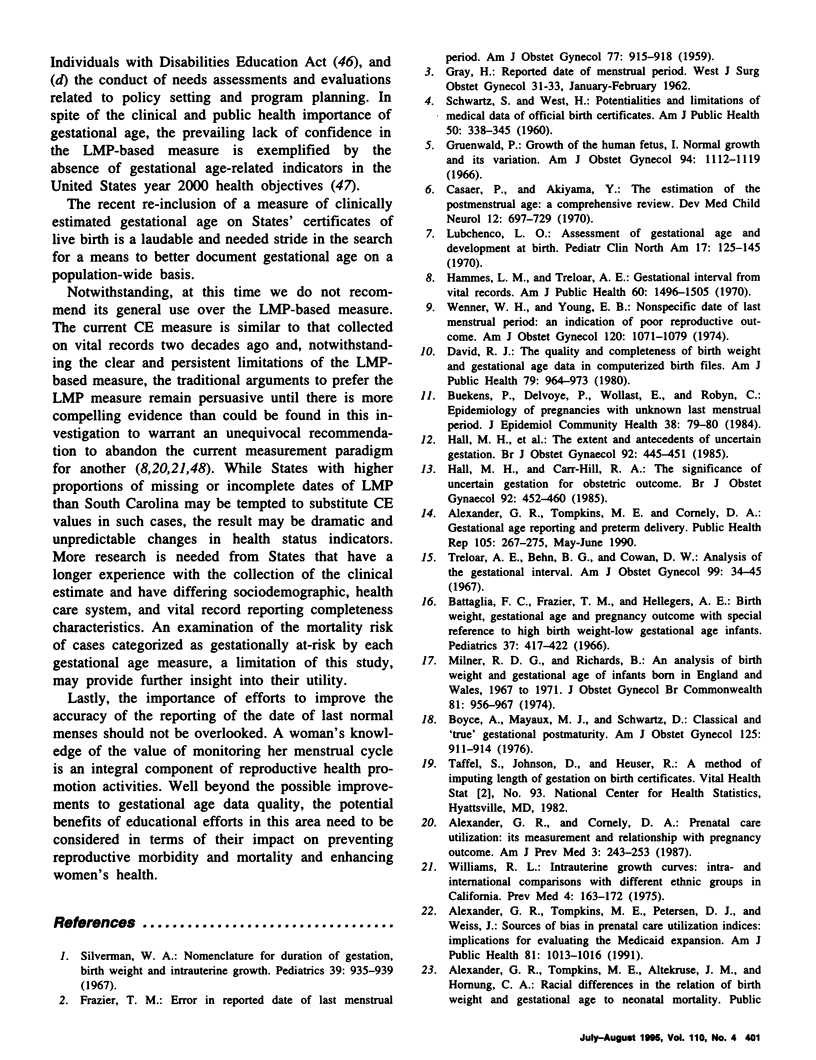Abstract
This study examines the comparability between the last menstrual period-based and clinically estimated gestational age as collected on certificates of live birth. It explores whether sociodemographic or delivery characteristics influence their agreement and contrasts health status and health care utilization indicators, such as preterm, small for gestational age, and adequacy of prenatal care percentages, produced by each gestational age measure. The 1989-91 South Carolina public use live birth files were used for this analysis. A total of 169,082 single births to resident mothers were selected for investigation. The clinically estimated gestational age distribution exhibited a higher mean and a tendency toward even number digit preference. The last menstrual period-based measure produced higher preterm and postterm percentages. More than 60 percent of the last menstrual period-based preterm births were classified as preterm by the clinical estimate. The sensitivity of the clinical estimate was 27 percent for postterm births. The overall concordance (the percentage of cases with the same value for both measures) was 47 percent, but it varied considerably by gestational age. Between 30 and 35 weeks, the clinical estimate exceeded the last menstrual period-based value by 2 weeks or more for more than 40 percent of the cases. Concordance also varied by race of mother, hospital delivery size, trimester prenatal care began, and birth weight. The last menstrual period-based and the clinically estimated gestational age distributions exhibited notable dissimilarities, produced marked differences in health status indicators, and varied in concordance by gestational age and by sociodemographic, prenatal care, and hospital characteristics.(ABSTRACT TRUNCATED AT 250 WORDS)
Full text
PDF







Selected References
These references are in PubMed. This may not be the complete list of references from this article.
- Alexander G. R., Cornely D. A. Prenatal care utilization: its measurement and relationship to pregnancy outcome. Am J Prev Med. 1987 Sep-Oct;3(5):243–253. [PubMed] [Google Scholar]
- Alexander G. R., Hulsey T. C., Smeriglio V. L., Comfort M., Levkoff A. Factors influencing the relationship between a newborn assessment of gestational maturity and the gestational age interval. Paediatr Perinat Epidemiol. 1990 Apr;4(2):133–146. doi: 10.1111/j.1365-3016.1990.tb00628.x. [DOI] [PubMed] [Google Scholar]
- Alexander G. R., Petersen D. J., Powell-Griner E., Tompkins M. E. A comparison of gestational age reporting methods based on physician estimate and date of last normal menses from fetal death reports. Am J Public Health. 1989 May;79(5):600–602. doi: 10.2105/ajph.79.5.600. [DOI] [PMC free article] [PubMed] [Google Scholar]
- Alexander G. R., Tompkins M. E., Cornely D. A. Gestational age reporting and preterm delivery. Public Health Rep. 1990 May-Jun;105(3):267–275. [PMC free article] [PubMed] [Google Scholar]
- Alexander G. R., Tompkins M. E., Petersen D. J., Weiss J. Source of bias in prenatal care utilization indices: implications for evaluating the Medicaid expansion. Am J Public Health. 1991 Aug;81(8):1013–1016. doi: 10.2105/ajph.81.8.1013. [DOI] [PMC free article] [PubMed] [Google Scholar]
- Alexander G. R., de Caunes F., Hulsey T. C., Tompkins M. E., Allen M. Ethnic variation in postnatal assessments of gestational age: a reappraisal. Paediatr Perinat Epidemiol. 1992 Oct;6(4):423–433. doi: 10.1111/j.1365-3016.1992.tb00786.x. [DOI] [PubMed] [Google Scholar]
- Alexander G. R., de Caunes F., Hulsey T. C., Tompkins M. E., Allen M. Validity of postnatal assessments of gestational age: a comparison of the method of Ballard et al. and early ultrasonography. Am J Obstet Gynecol. 1992 Mar;166(3):891–895. doi: 10.1016/0002-9378(92)91357-g. [DOI] [PubMed] [Google Scholar]
- Allen M. C., Alexander G. R. Using gross motor milestones to identify very preterm infants at risk for cerebral palsy. Dev Med Child Neurol. 1992 Mar;34(3):226–232. doi: 10.1111/j.1469-8749.1992.tb14995.x. [DOI] [PubMed] [Google Scholar]
- American Academy of Pediatrics. Committee on fetus and newborn. Nomenclature for duration of gestation, birth weight and intra-uterine growth. Pediatrics. 1967 Jun;39(6):935–939. [PubMed] [Google Scholar]
- Andersen H. F., Johnson T. R., Jr, Barclay M. L., Flora J. D., Jr Gestational age assessment. I. analysis of individual clinical observations. Am J Obstet Gynecol. 1981 Jan 15;139(2):173–177. [PubMed] [Google Scholar]
- Ballard J. L., Khoury J. C., Wedig K., Wang L., Eilers-Walsman B. L., Lipp R. New Ballard Score, expanded to include extremely premature infants. J Pediatr. 1991 Sep;119(3):417–423. doi: 10.1016/s0022-3476(05)82056-6. [DOI] [PubMed] [Google Scholar]
- Ballard J. L., Novak K. K., Driver M. A simplified score for assessment of fetal maturation of newly born infants. J Pediatr. 1979 Nov;95(5 Pt 1):769–774. doi: 10.1016/s0022-3476(79)80734-9. [DOI] [PubMed] [Google Scholar]
- Battaglia F. C., Frazier T. M., Hellegers A. E. Birth weight, gestational age, and pregnancy out- come, with special reference to high birth weight-low gestational age infant. Pediatrics. 1966 Mar;37(3):417–422. [PubMed] [Google Scholar]
- Boyce A., Mayaux M. J., Schwartz D. Classical and "true" gestational postmaturity. Am J Obstet Gynecol. 1976 Aug 1;125(7):911–914. doi: 10.1016/0002-9378(76)90487-7. [DOI] [PubMed] [Google Scholar]
- Brenner W. E., Edelman D. A., Hendricks C. H. A standard of fetal growth for the United States of America. Am J Obstet Gynecol. 1976 Nov 1;126(5):555–564. doi: 10.1016/0002-9378(76)90748-1. [DOI] [PubMed] [Google Scholar]
- Buekens P., Delvoye P., Wollast E., Robyn C. Epidemiology of pregnancies with unknown last menstrual period. J Epidemiol Community Health. 1984 Mar;38(1):79–80. doi: 10.1136/jech.38.1.79. [DOI] [PMC free article] [PubMed] [Google Scholar]
- Casaer P., Akiyama Y. The estimation of the postmenstrual age: a comprehensive review. Dev Med Child Neurol. 1970 Dec;12(6):697–729. doi: 10.1111/j.1469-8749.1970.tb07862.x. [DOI] [PubMed] [Google Scholar]
- David R. J. The quality and completeness of birthweight and gestational age data in computerized birth files. Am J Public Health. 1980 Sep;70(9):964–973. doi: 10.2105/ajph.70.9.964. [DOI] [PMC free article] [PubMed] [Google Scholar]
- Dubowitz L. M., Dubowitz V., Goldberg C. Clinical assessment of gestational age in the newborn infant. J Pediatr. 1970 Jul;77(1):1–10. doi: 10.1016/s0022-3476(70)80038-5. [DOI] [PubMed] [Google Scholar]
- FRAZIER T. M. Error in reported date of last menstrual period. Am J Obstet Gynecol. 1959 Apr;77(4):915–918. doi: 10.1016/s0002-9378(16)36804-1. [DOI] [PubMed] [Google Scholar]
- Gruenwald P. Growth of the human fetus. I. Normal growth and its variation. Am J Obstet Gynecol. 1966 Apr 15;94(8):1112–1119. doi: 10.1016/0002-9378(66)90774-5. [DOI] [PubMed] [Google Scholar]
- Hall M. H., Carr-Hill R. A., Fraser C., Campbell D., Samphier M. L. The extent and antecedents of uncertain gestation. Br J Obstet Gynaecol. 1985 May;92(5):445–451. doi: 10.1111/j.1471-0528.1985.tb01347.x. [DOI] [PubMed] [Google Scholar]
- Hall M. H., Carr-Hill R. A. The significance of uncertain gestation for obstetric outcome. Br J Obstet Gynaecol. 1985 May;92(5):452–460. doi: 10.1111/j.1471-0528.1985.tb01348.x. [DOI] [PubMed] [Google Scholar]
- Hammes L. M., Treloar A. E. Gestational interval from vital records. Am J Public Health Nations Health. 1970 Aug;60(8):1496–1505. doi: 10.2105/ajph.60.8.1496. [DOI] [PMC free article] [PubMed] [Google Scholar]
- Jimenez J. M., Tyson J. E., Reisch J. S. Clinical measures of gestational age in normal pregnancies. Obstet Gynecol. 1983 Apr;61(4):438–443. [PubMed] [Google Scholar]
- Kramer M. S., McLean F. H., Boyd M. E., Usher R. H. The validity of gestational age estimation by menstrual dating in term, preterm, and postterm gestations. JAMA. 1988 Dec 9;260(22):3306–3308. [PubMed] [Google Scholar]
- Lubchenco L. O. Assessment of gestational age and development of birth. Pediatr Clin North Am. 1970 Feb;17(1):125–145. doi: 10.1016/s0031-3955(16)32381-1. [DOI] [PubMed] [Google Scholar]
- Milner R. D., Richards B. An analysis of birth weight by gestational age of infants born in England and Wales, 1967 to 1971. J Obstet Gynaecol Br Commonw. 1974 Dec;81(12):956–967. doi: 10.1111/j.1471-0528.1974.tb00414.x. [DOI] [PubMed] [Google Scholar]
- Ott W. J. Accurate gestational dating. Obstet Gynecol. 1985 Sep;66(3):311–315. [PubMed] [Google Scholar]
- Petersen D. J., Alexander G. R., Powell-Griner E., Tompkins M. E. Variations in the reporting of gestational age at induced termination of pregnancy. Am J Public Health. 1989 May;79(5):603–606. doi: 10.2105/ajph.79.5.603. [DOI] [PMC free article] [PubMed] [Google Scholar]
- Robillard P. Y., De Caunes F., Alexander G. R., Sergent M. P. Validity of postnatal assessments of gestational age in low birthweight infants from a Caribbean community. J Perinatol. 1992 Jun;12(2):115–119. [PubMed] [Google Scholar]
- Sanders M., Allen M., Alexander G. R., Yankowitz J., Graeber J., Johnson T. R., Repka M. X. Gestational age assessment in preterm neonates weighing less than 1500 grams. Pediatrics. 1991 Sep;88(3):542–546. [PubMed] [Google Scholar]
- Shukla H., Atakent Y. S., Ferrara A., Topsis J., Antoine C. Postnatal overestimation of gestational age in preterm infants. Am J Dis Child. 1987 Oct;141(10):1106–1107. doi: 10.1001/archpedi.1987.04460100084033. [DOI] [PubMed] [Google Scholar]
- Shwartz S., West H. Potentialities and Limitations of Medical Data on Official Birth Certificates. Am J Public Health Nations Health. 1960 Mar;50(3 Pt 1):338–345. doi: 10.2105/ajph.50.3_pt_1.338. [DOI] [PMC free article] [PubMed] [Google Scholar]
- Spinnato J. A., Sibai B. M., Shaver D. C., Anderson G. D. Inaccuracy of Dubowitz gestational age in low birth weight infants. Obstet Gynecol. 1984 Apr;63(4):491–495. [PubMed] [Google Scholar]
- Treloar A. E., Behn B. G., Cowan D. W. Analysis of gestational interval. Am J Obstet Gynecol. 1967 Sep 1;99(1):34–45. doi: 10.1016/s0002-9378(16)34488-x. [DOI] [PubMed] [Google Scholar]
- Wenner W. H., Young E. B. Nonspecific date of last menstrual period: an indication of poor reproductive outcome. Am J Obstet Gynecol. 1974 Dec 15;120(8):1071–1079. doi: 10.1016/0002-9378(74)90152-5. [DOI] [PubMed] [Google Scholar]
- Williams R. L. Intrauterine growth curves: intra- and international comparisons with different ethnic groups in California. Prev Med. 1975 Jun;4(2):163–172. doi: 10.1016/0091-7435(75)90081-x. [DOI] [PubMed] [Google Scholar]


